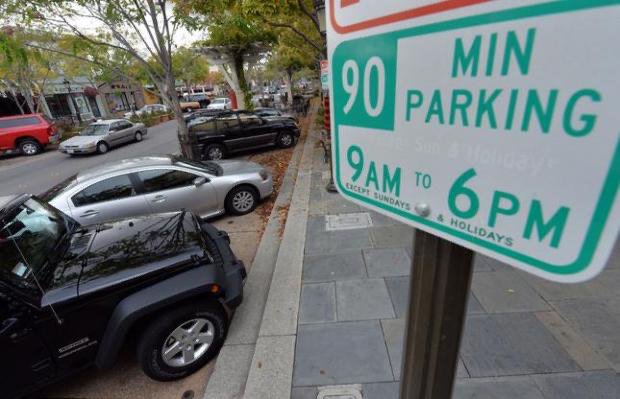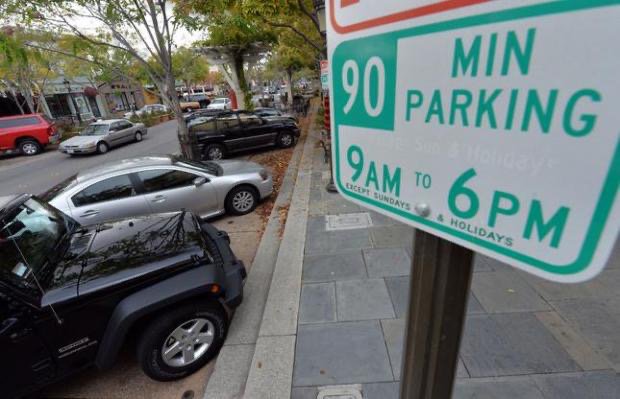Want absolute proof downtown Manteca doesn’t have a parking problem?
Just head downtown This Saturday or Sunday from 10 a.m. to 6 p.m.
The Pumpkin Fair typically attracts 30,000 to 40,000 people over two days.
Rest assured most attendees are parking two to three blocks away, if not more.
One might argue, that is a parking problem.
No it isn’t.
It’s because in the context of people’s willingness to attend the event, not being able to park across the street from the entertainment main stage in Wilson Park isn’t a deal killer.
As such it underscores how one’s perspective clouds one’s judgment.
What matters most to the success of downtown is the desire of people to patronize what is available there.
There’s a bookshop in downtown Pleasanton as well as a select few restaurants we will occasionally visit on an early Saturday afternoon.
The closest we have ever parked is three blocks away.
The same is true of a pub-style restaurant in downtown Livermore.
Clearly, we are not alone.
Would people walk three blocks to do routine shopping such as for groceries and sundry items?
Highly unlikely.
That said there are a lot of people who walk the equivalent of one or two downtown Manteca city blocks to reach the entrance of Costco or Walmart.
No one in their right mind would assume it would work if people had to push a cart load of Costco purchases down three actual downtown-style blocks of sidewalks, including crossing streets, to reach their car.
By the same token, people aren’t in their right mind if they think downtown Manteca is either a traditional retail hub of any consequence or needs the same parking convenience requirements a strip mall or stand alone small, medium or large box retailer needs to thrive.
There is a reason people will walk a block or two to reach an event at the FESM and MRPS halls as well as The Veranda Events Center and the Deaf Puppy Comedy Club.
They are “destination” venues where people dine, celebrate, seek entertainment, and gather to socialize.
Yes, that has been almost always the case from day one when what is now the downtown core was established.
But now, assuming everyone is to be believed including those with a death grip on the perception downtown currently has a parking problem, the want and desire is a Manteca-version of reinvented downtown cores.
The best regional examples in cities close to Manteca’s size are Pleasanton, Livermore, Tracy, Lodi, and Turlock.
In all cases, the parking to access those city cores is not nearly as robust during peak demand times as traditional retail.
Manteca, as an example, required that Target when it was built more than two decades ago, have enough parking spaces to essentially accommodate vehicles on its busiest retail days of the year from Black Friday to Christmas Eve.
The city refused to deviate from that number by a dozen or so spaces to make it possible for a sit down chain restaurant that was interested in opening along Spreckels Avenue on what is now the northwest corner of Target’s parking lot.
There was an area large enough for the restaurant and three quarters of the city required parking.
So today, Target has roughly 50 more spaces than it was ever required to have and the parking lot has never been much more than half full back in the day when everyone shopped in person.
The bad side effects of such peak parking demand requirements being imposed has meant increasing the urban heat footprint, increasing storm runoff that adds to the accumulative increasing of flood risk in the overall valley basin, and a colossal waste of land.
Applying such a mentality to a core downtown district is the equivalent of putting shackles and chains on a distance runner and expecting them to win the Boston Marathon.
It might seem like an odd analogy, but it isn’t.
Everyone has these great expectations of downtown glory and creating a unique commercial area that can go the distance but then they immediately throw up roadblocks with requirements that aren’t justified.
And the bottom line justification for parking is this: How far are people willing to walk for something they really want to patronize?
The answer can be found this weekend in downtown Manteca.
And it can be found throughout the week in downtowns in Pleasanton, Livermore, Tracy, and Lodi.
Going hand-in-hand with that willingness to walk is the need to make downtowns walkable.
It needs to be a safe, comfortable, and pleasing experience.
And you can’t make downtown walkable if you demand the city always make auto access the No. 1 priority.
In the case of Manteca, that means modern 1990 and forward parking standards for retail/restaurants to apply everywhere in the city including the downtown core.
The city does need to de-emphasize vehicle movements.
It can’t get away from the fact Main Street will always be a major north-south arterial.
As for Yosemite Avenue — an east-west arterial connecting two outlying commercial districts with downtown — it could one day be converted to non-through traffic.
All it takes is pursuing a vision advanced by Mayor Gary Singh to divert Yosemite Avenue after it crosses the tracks to run behind the north side of the 100-300 blocks of East Yosemite and connect with Moffat Boulevard.
From there traffic bound to the commercial area by Highway 99 can go back to Yosemite by turning left when Moffat meets Spreckels Avenue.
None of this means traditional retail and services — there are seven banking style institutions — can’t survive and thrive in downtown in including four specialty groceries.
There is almost no overlap with “destination” venues such as restaurants and such when it comes to parking.
And as the detailed ACEM parking survey indicates, there is an overall parking surplus.
The perceived lack of downtown parking hasn’t hurt the Manteca Pumpkin Fair.
Nor will it hurt any concern that offers people what they want in terms of entertainment, dining, or socializing wants and desires.
This column is the opinion of editor, Dennis Wyatt, and does not necessarily represent the opinions of The Bulletin or 209 Multimedia. He can be reached at dwyatt@mantecabulletin.com





